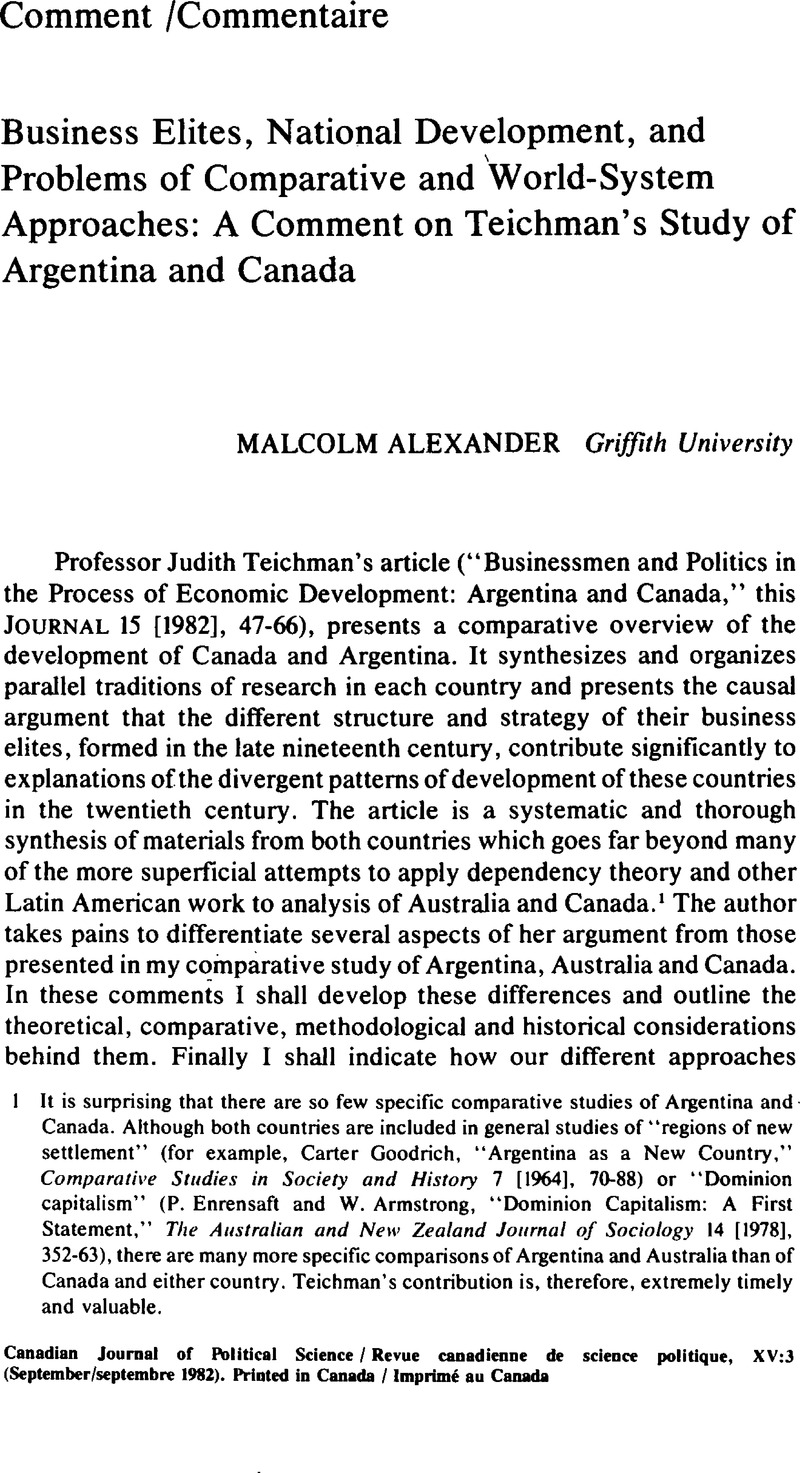No CrossRef data available.
Article contents
Business Elites, National Development, and Problems of Comparative and World-System Approaches: A Comment on Teichman's Study of Argentina and Canada
Published online by Cambridge University Press: 10 November 2009
Abstract

- Type
- Comment/Commentaire
- Information
- Canadian Journal of Political Science/Revue canadienne de science politique , Volume 15 , Issue 3 , September 1982 , pp. 589 - 595
- Copyright
- Copyright © Canadian Political Science Association (l'Association canadienne de science politique) and/et la Société québécoise de science politique 1982
References
1 It is surprising that there are so few specific comparative studies of Argentina and Canada. Although both countries are included in general studies of “regions of new settlement” (for example, Carter Goodrich, “Argentina as a New Country,” Comparative Studies in Society and History 7 [1964], 70–88) or “Dominion capitalism” (Enrensaft, P. and Armstrong, W., “Dominion Capitalism: A First Statement,” The Australian and New Zealand Journal of Sociology 14 [1978], 352–63), there are many more specific comparisons of Argentina and Australia than of Canada and either country. Teichman's contribution is, therefore, extremely timely and valuable.CrossRefGoogle Scholar
2 Although core, periphery and semiperiphery are supranational regions, world-system theory also allows an integration of subnational regional differences into its analysis. This is an extremely important phenomenon in both Australia and Canada, as Garth Stevenson's comparative study shows (see Stevenson, , Mineral Resources and Australian Federalism [Canberra: Center for Research on Federal Financial Relations, Australian National University Research Monograph number 17, 1977])Google Scholar. A recent study of Australian urbanization utilizes such regional differences to comment upon world-system changes (see Mullins, P., “Theoretical Perspectives on Australian Urbanisation: Material Components in the Reproduction of Australian Labour Power,” The Australian and New Zealand Journal of Sociology 17 [1981], 65–76).CrossRefGoogle Scholar
3 See Wallerstein, , The Modern World-System: Capitalist Agriculture and the Origins of the European World-Economy in the Sixteenth Century (New York: Academic Press, 1974).Google Scholar
4 The need to consider class struggle rather than the structure of any single class is applied in a recent reinterpretation of Australian history (see Connell, R. W. and Irving, T. H., Class Structure in Australian History: Documents, Variations and Arguments [Melbourne: Longman Chesire, 1980])Google Scholar. I have commented on the similarities of world-system analysis and this approach (“Historical Social Science: Class Structure in the Modern World System,” The Australian and New Zealand Journal of Sociology 17 [1981], 56–64)CrossRefGoogle Scholar. The greater emphasis on the construction of the state machinery itself is also taken up in the work of Theda Skocpol (States and Social Revolutions: A Comparative Analysis of France, Russia and China [Cambridge: Cambridge University Press, 1979]). Compare Skocpol with Alexander, “The Political Economy of Semi-Industrial Capitalism: A Comparative Study of Argentina, Australia and Canada, 1950–1970”(unpublished doctoral dissertation, McGill University, 1979), chap. 2.Google Scholar
5 See, for example, Goodrich, , “Argentina as a New Country”; Frank, A. G., Lumpen-bourgeoisie: Lumpendevelopment; Dependence, Class and Politics in Latin America (New York: Monthly Review Press, 1972), 56Google Scholar; McCarty, J. W., “Australia as a Region of Recent Settlement in the Nineteenth Century,” Australian Economic History Review 13 (1973), 148–67CrossRefGoogle Scholar; Theodore Moran, H., “The ‘Development’ of Argentina and Australia: The Radical Party of Argentina and the Labor Party of Australia in the Process of Economic and Political Development,” Comparative Politics 3 (1970), 71–92CrossRefGoogle Scholar; and Wheelwright, E. L. and Ferrer, A., “Australia and Argentina: A Comparative Study,” in Wheelwright, (ed.), Radical Political Economy: Collected Essays (Sydney: ANZ Book Company, 1974), 270–96.Google Scholar
6 Compare Goodrich, , “Argentina as a New Country,” 72.Google Scholar
7 Teichman, , “Businessmen and Politics,” 47–48, n. 1.Google Scholar
8 Goodrich, , “Argentina as a New Country,” 82.Google Scholar
9 This pattern was different to that in both Australia and Canada and led me to argue that Argentina had an underutilization of her export potential. A similar hypothesis is suggested by Barrie Dyster from his study of Argentina and Australia's divergent growth in the early nineteenth century (“Argentine and Australian Development Compared,” Past and Present 84 [1979], 91–110).CrossRefGoogle Scholar
10 Remmer, , “Economic Dependency and Political Conflict: Chile and Argentina, 1900–25,” Studies in Comparative International Development 11 (1976), 3–24.CrossRefGoogle Scholar
11 Teichman argues that mineral exploration was suppressed by the Argentinian elite for fear that their discovery would stimulate heavy industry to compete with British exports. This is an important question which I discussed, suggesting several other reasons for this fact (“The Political Economy of Semi-Industrial Capitalism,” 27–29).
12 Teichman, “Businessmen and Politics,” 65, n. 55.




